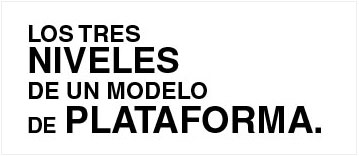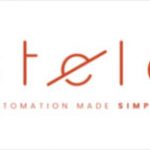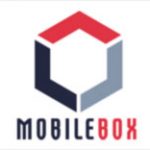
En los modelos tradicionales, simplificando, se habla de “Cadena de Valor”. El término es bueno cuando existe linealidad: se parte de unos insumos, luego se produce, el producto es distribuido, promocionado y vendido, para luego dar lugar al servicio de post-venta. En este marco se dan dos tipos de integraciones: Vertical y Horizontal.
En el contexto de negocio actual, cada vez más, pensamos en modelos de negocio basados en plataformas, en los que no existe la linealidad de la cadena de valor y de donde surge un nuevo tipo de integración, que llamamos: Concéntrica. El modelo de negocio basado en plataforma se puede representar en tres niveles delimitados por tres líneas: Línea del Core, Línea de Integración y Línea de Intercambio.
Sobre la Línea del Core se encuentra el Nivel I, que constituye el cimiento sobre el cuál se edifica y fundamenta el modelo. El Nivel I es el del Core y cuenta con todas las funcionalidades y servicios que serán utilizados por las aplicaciones que se integren, independientemente de la necesidad que satisfagan en el cliente final. Sobre la Línea de Integración está el Nivel II, aquí se procesa toda la interacción entre oferta (Soluciones) y demanda (Bancos) y es donde se identifican necesidades de mercado y capacidades, y se realiza la integración de las diferentes soluciones al Core. Sobre la Línea de Intercambio (Nivel III) se encuentran las soluciones que llegan al cliente final y satisfacen deseos, expectativas y necesidades concretas. Cada nivel tiene sus características, componentes y propósito. A continuación, se brinda un detalle de cada uno de ellos.
Nivel I: Core
Constituye la base sobre la cual es posible construir productos o servicios para satisfacer las necesidades de usuarios y/o clientes finales. El Core es un sistema extensible que provee funcionalidades que son compartidas por las diferentes aplicaciones que inter-operan con él y la interfaz de integración necesaria para que éstas puedan incorporarse al mismo.
Las tres características fundamentales que debe tener el Nivel I (Core) son:
+ Scalability
+ Security
+ Extensibilidad
Todo Core que opere como cimiento en un modelo de Plataforma, debe ser escalable, seguro y extensible.
Escalable implica que tiene que poder funcionar como un cimiento sobre el cual se pueden construir muchos “pisos”. En el caso de los Core Bancarios, implica, entre otros, que deben poder procesar millones de transacciones diarias sin interrupciones.
Seguridad implica muchas cosas, tiene que ver con la seguridad de la información que se gestiona, con la tranquilidad de que se procesará toda la información en tiempo y forma, con el aseguramiento de la integridad y la consistencia de lo que se procesa.
Extensible implica que el Core debe, necesariamente, poder integrarse con otros sistemas. En el caso de los Core Bancarios implica contar con un API Banking para facilitar este proceso de integración.
Los componentes clave son:
- API Banking: La interfaz de programación de aplicaciones es fundamental en todo Core, ya que brinda la posibilidad de comunicación entre éste y los sistemas que se integran.
- DevOps: Esta práctica de ingeniería implica una visión unificadora del desarrollo y la operación y tiene por propósito lograr ciclos cortos de desarrollo con implementaciones frecuentes y productos que se ajusten a los requerimientos. Implica, entre otras cosas, contar con herramientas para cada etapa del ciclo de desarrollo y operaciones, que funcionen de forma integrada, automatizando y facilitando el proceso de punta a punta.
- Sistemas: La plataforma debe ofrecer una serie de funcionalidades que son utilizadas por las diferentes aplicaciones que se integran a la misma. Generalmente se trata de sistemas de gran tamaño y complejidad, que son necesarios para las organizaciones que desarrollan aplicaciones para el usuario final pero que no representan el foco de atención de éstas. A modo de ejemplo, si una organización que desarrolla una aplicación de “onboarding” digital tuviera que desarrollar todos los procesos que necesariamente deben realizarse a nivel del Core, se expondría a costos, tiempos y riesgos que probablemente harían inviable el emprendimiento.
- Conocimiento: El Core no solo contiene sistemas, sino que también embebe un “conocimiento” en sus procesos. Al ofrecer este conocimiento a las empresas que se integran mediante sus aplicaciones, brindan la posibilidad de que cada uno se especialice en donde tienen su fortaleza. Por ejemplo, el desarrollador de la aplicación podría poner todos sus esfuerzos en mejorar la experiencia del cliente mediante soluciones cercanas, convenientes y eficientes, sin tener que conocer todos los detalles de la vertical en la que opera. Este es parte del valor que se desprende de los modelos de Plataforma.
El propósito del Nivel I es lograr: “Robustez Integrable”.
El Core representa el cimiento, el lugar sobre el cual otras soluciones pueden edificar, agregando valor con máxima estabilidad.
Nivel II: Integración
El Nivel II es donde se produce la Integración. Es el lugar donde se une oferta y demanda. En el caso de negocios B2B (Business to Business), nos referimos a la demanda de empresas con oferta de empresas que desarrollan soluciones. En este punto es clave no confundir intermediación con integración, las soluciones que compran las empresas, pongamos por caso a los Bancos, están integradas a la plataforma bancaria que utiliza el Banco. Por otro lado, la interacción entre oferta y demanda es directa. En el caso de Bantotal, es el Developer (oferta) quien presenta su solución al Banco (demanda) y quien la instala.
Las tres características fundamentales que se observan en el Nivel II (Integración) son:
+ Coopetencia
+ Specialization
+ Facilidad
La existencia de “Coopetencia” implica un cambio de paradigma. En los modelos de negocios tradicionales existen actores que son competidores y otros que son colaboradores. Sin embargo, en el nuevo contexto de negocio un mismo actor puede ser competidor y colaborador al mismo tiempo.
En un mundo que revoluciona, en el que los cambios cada vez son más rápidos, la cantidad de soluciones disponibles cada vez son más y en el que la frecuencia de las actualizaciones es mayor, la “Especialización” cobra especial relevancia. No podemos pretender que un solo proveedor ofrezca todas las soluciones necesarias. La contracara de la especialización es la colaboración y la base que facilita esta integración es el Core como Plataforma.
Una tercera característica fundamental es la “Facilidad”, el Nivel II debe facilitar la interacción entre los dos lados del mercado, entre oferta y demanda.
Los componentes clave son:
- Oferta: Organizaciones que desarrollan soluciones que tienen el potencial de contribuir a satisfacer una necesidad, deseo o expectativa del cliente del Banco.
- Demanda: Instituciones Financieras que tienen que satisfacer a sus clientes con soluciones convenientes, cercanas y eficientes.
El propósito en el Nivel II es maximizar la: “Interacción”.
Todo modelo basado en plataforma debe maximizar la interacción directa entre oferta y demanda. Esa interacción es la que crea valor para el cliente final y genera externalidades cruzadas. Cuanto mayor sea la cantidad de interacción mayor será el grado en que se podrán satisfacer las necesidades de los clientes finales creando relaciones más profundas, amplias y duraderas. En la medida de que pasa esto último, mayores serán los beneficios para las partes que interactúan y para el proveedor de la plataforma. En otros términos, el modelo de negocio basado en plataforma implica agregar valor a través de la facilitación de la interacción entre dos tipos diferentes de actores, que en este caso llamamos, Bancos y Developers.
Nivel III: Intercambio
El nivel III es donde se produce el intercambio de valor con el cliente final.
Las tres características que se destacan en este Nivel III (Intercambio) son:
+ Abundancia de soluciones: La interacción generada entre los Developers y las Instituciones brinda la posibilidad de ofrecer distintas soluciones, una por cada necesidad. La disrupción tecnológica ha permitido la multiplicación de los momentos en la vida de una persona en la que, por ejemplo, una Institución Financiera puede participar y agregar valor.
+ Alta velocidad de las actualizaciones: El alto grado de especialización, los marcos de trabajo “Ágiles” y la facilidad de integración posibilitan un aumento en la frecuencia de las actualizaciones de las aplicaciones.
+ Alto grado de personalización: La tendencia es hacia mayores posibilidades de personalización por parte de cada aplicación.
Los componentes clave son: Conveniencia, Cercanía y Eficiencia.
El contexto de negocio actual implica un cambio en la forma de relacionamiento existente entre las instituciones y sus clientes. Se han multiplicado la cantidad de momentos en la vida de una persona en que la Institución es capaz de aportar valor. Esto implica que el Banco puede aportar valor en cualquier momento de la vida de una persona, que derive en una transacción económica. A este nuevo contexto lo denominamos: “Life Banking”.
Las soluciones deben tener tres características:
- Conveniencia, se trata de soluciones simples, completas y precisas que reducen al máximo el esfuerzo físico y mental del cliente.
- Cercanía, el Banco es quien se acerca al cliente, permitiéndole operar desde el lugar en donde se encuentre y debe recopilar y analizar los datos que develen las necesidades, deseos y expectativas para mejorar las ofertas.
- Eficiencia, se deben reducir los tiempos de servicio y los costos, automatizando todo aquello que se pueda automatizar.
El propósito en el Nivel III es: “Experiencia del cliente”.
Es importante diseñar la experiencia del cliente a lo largo de todo el proceso (Customer Journey), desde que se entera que la solución existe hasta que la comienza a usar a lo largo del tiempo. Todos los puntos de contacto (puntos de interacción que involucran a una necesidad humana específica en un tiempo y lugar específico), deben ser considerados y planificados. Todo plan debe incluir un estado de situación actual, un estado de situación deseado, un plan de acción para llegar desde el lugar en donde se está al lugar que se quiere llegar, y un conjunto de indicadores que permitan identificar si se está transitando en el camino correcto o existen desvíos que deben ser corregidos. En síntesis, es fundamental identificar el “Customer Journey” y definir cómo queremos que sea la experiencia de nuestro cliente en cada fase del mismo, ajustando nuestras propuestas para alcanzar dichos objetivos.
Mentalidad Digital y Agilidad Organizacional
El esquema de pensamiento y el enfoque organizacional son elementos transversales al modelo. El primero, al que denominamos Mentalidad Digital, tiene que ver con una forma de entender la realidad actual y un conjunto de habilidades y competencias, desarrolladas a partir de unas creencias, que permiten contar con conductas adecuadas para explotar todo el potencial del contexto. Por su parte, la Agilidad Organizacional refiere a un enfoque de trabajo basado en procesos Iterativos e Incrementales, que permiten recibir feedback, asegurándose la entrega temprana y continua de soluciones que satisfacen las necesidades y expectativas del mercado, en un entorno que revoluciona.
________________________________





Post a comment